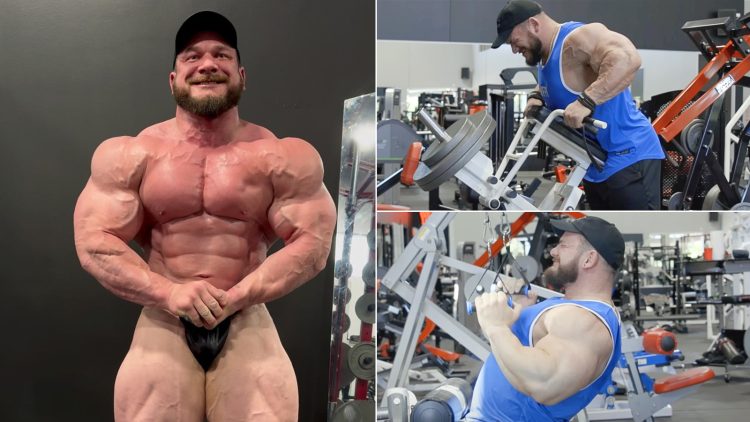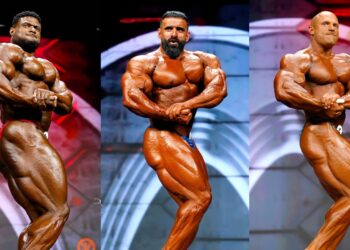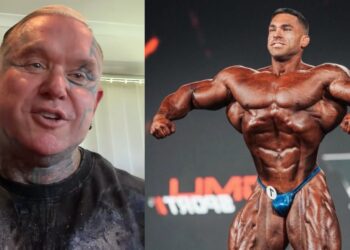Hunter Labrada is fine-tuning his physique ahead of his next competition, which has yet to be revealed. In a recent YouTube video, Labrada walked fans through his latest pull-day for building a bigger back and lats in the off-season.
“Back training is not really rocket science it’s just knowing what you’re trying to target and keeping in mind the queues that you’re trying to do so with,” says Hunter Labrada.
Open bodybuilders all know now after Derek Lunsford’s 2023 Olympia victory that you have to have a massive and defined back if you want to stand next to the best in the world. This is why Labrada has taken his back training up a notch for the season.
Hunter Labrada Smashes Pull Day Back Training Session in 2024 Off-Season
Before placing sixth at the 2023 Olympia show, Labrada showcased arguably the strongest physique of his career with a dominant win at the Tampa Pro. Should he continue to nail his peaks and dial in his conditioning, many believe he will be a true threat to Lunsford’s title on the horizon.
Level Up Your Fitness: Join our 💪 strong community in Fitness Volt Newsletter. Get daily inspiration, expert-backed workouts, nutrition tips, the latest in strength sports, and the support you need to reach your goals. Subscribe for free!
Check out Hunter Labrada’s workout below:
- Landmine row — 2 working sets
- Lower lat-focused pulldown with Nautilus machine — 2 working sets
- chest-supported t-bar row — 2 working sets
- Cable lat pulldown — 2 working sets
- Machine rear delt flies — 2 working sets
Landmine rows
First, Labrada explains how he uses gravity to his advantage during reps of Landmine rows.
“The biggest thing that the t-bar allows us to do it allows us to play with our center of gravity is set up. We are going to use that to our advantage.
What I want you to think about is getting your center of gravity over the bar enough to when you row it up you’re pulling it to your midline.”
Lower lat-focused pulldown with Nautilus machine
Even if you don’t have a Nautilus machine for lower lat pulldowns, Labrada explains that this movement can be replicated with any cable machine.
“If you don’t have the Nautlius you can do these the exact same way with any cable machine. Either setting up a bench or just using the existing seat. I would say setting up a bench though is better. Setting up a bench here so you have a little bit more pull,” said Labrada.
He advised lifters to think about engaging the lats while keeping the upper arm externally rotated. The elbows should remain close to the body.
“What we’re aiming to do here is to really think about what we’re wanting to do to engage our lats so that is to keep that upper arm externally rotated, elbow close, and as we pull through keeping that elbow close to our body.”
Chest supported t-bar row
For chest-supported t-bar rows, Labrada emphasized the importance of a proper arm path.
“What makes an exercise upper-back focused you may ask? The arm path. So up until now we have been taking a very close arm path, keeping that elbow close to our body whether it’s a row or a pulldown, now I’m moving the focus to the upper back musculature.”
“That arm path is going to change from close to the body to out here, not chicken wings, we are not trying to train rear delts on all the exercises, just taking a very natural arm path rowing.”
Machine lat pulldown
During reps of machine lat pulldowns, Labrada says to keep a rigid spine for the best results.
“A pulldown for our upper back. What that is going to look like is over there, a pretty rigid spine, very little flexion either way and just getting a nice full protraction and getting our elbows down and back as far as we can and getting a full retraction.”
“You’re going to have a full protraction with that neutral spine. Notice I’m not like this [leaning forward] notice I’m not like that [leaning back]. My scapula and shoulders are in a full as much extension as they are going to get being stretched. To initiate the exercise I’m thinking down and back with my shoulders at the same time and driving my elbows down as far as I can get them.”
Machine rear delt flyes
Lastly, to hit the rear delts, Labrada practices rear delt flies.
“The biggest thing that I see people do wrong with these or they want to get themselves straight forward, see how it’s not very natural and his shoulders open up that way [left] to get us through the range of motion. Watch what happens when he scoots his hips back a little, we are able to get this rear delt nice and lined up with that line of pull.”
“We are able to get that rear delt nice and short as it gets towards the back of this contraction. Keep in mind also, we are doing these for our rear delts, not our traps.”
He specified that he completed a total of 10 working sets during this training session.
“In total, including those two sets of rear delts, we did 10 working sets, four exercises for back, two working sets a pop and two working sets on the rear delt flyes to finish.
Although he hasn’t stepped foot on stage this year, Hunter Labrada has remained a busy man within the bodybuilding community. In addition to opening up about his modified push-pull legs training split, he discussed the benefits of creatine and optimal dosages.
Labrada has also been training intensely and even pumped iron alongside bodybuilding star Sam Sulek recently. During the training session, Hunter offered insight to the fitness star, who has plans to enter the Classic Physique category in a year or two.
Judging by Hunter Labrada’s back workout, he is leaving no stone unturned before stepping back on stage. Fans look forward to seeing him qualify for this year’s 2024 Mr. Olympia, set to take place in Las Vegas, Nevada October 10-13.
RELATED: Samir Bannout Says If Hunter Labrada Wants to Win, He Needs to Get ‘Shredded to the Bone’









